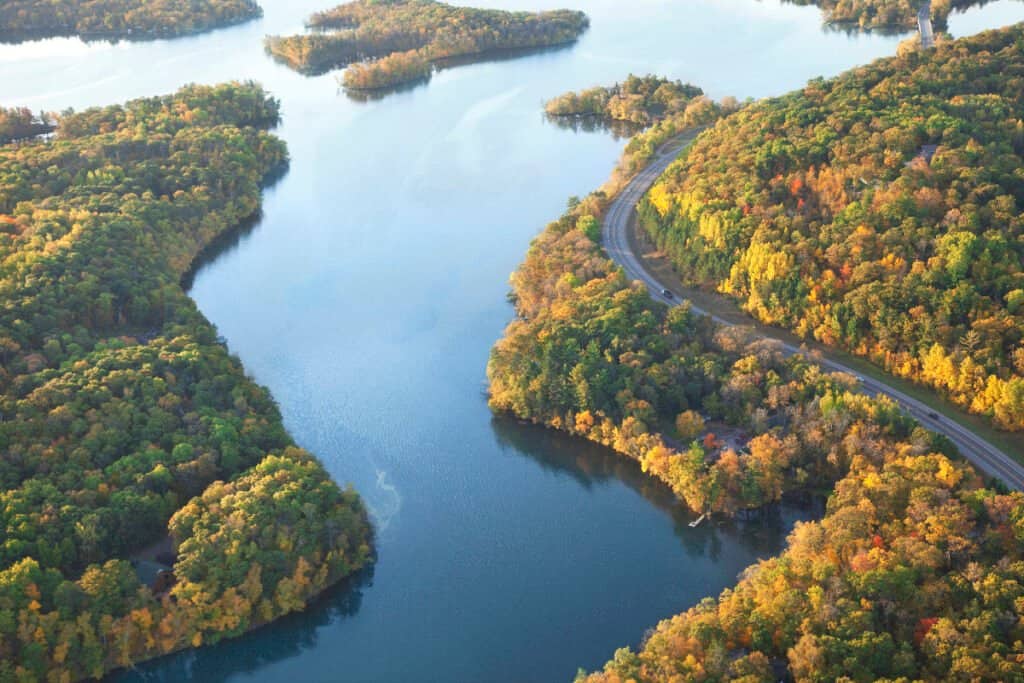The Great Mississippi Flood of 1927 was one of the worst national disasters in the United States’ history. Heavy rains started in the summer of 1926 and continued for months with the biggest fallout in April and May of 1927. Think of all the states along the Mississippi River that would be affected by a massive flood. Eleven states in all sustained damage and recovery efforts. How long did the Great Mississippi Flood last? What was the extent of the flooding? How many people died during the flood? Could a flood like this happen again? Let’s find out!
What caused the Great Mississippi Flood of 1927?

The worst flood in the United States was the Great Mississippi Flood of 1927.
©iStock.com/Willard
Unprecedented rainfalls from the summer of 1926, into the fall, that continued until the spring of 1927 led to the flood. Heavy rainfalls in early to mid-April were the breaking point. In New Orleans, on April 15, 1927, there was a reported 14 inches of rain. That is more than a foot! Other states reported downfalls that lasted 48 hours straight and the rainy weather system seemed to rain and repeat. It was a vicious cycle.
Did the Mississippi flood all at once?
The disaster gradually spread along the Mississippi. As early as September of 1926, areas along the Mississippi in Kansas and Iowa were almost overflowing. By December, the Cumberland River in Tennessee was more than 56 feet deep. Downstream on April 21, 1927, in Greenville, Mississippi, the levy broke at Mound Landing in lower Bolivar County. Ten days later, there were a million acres of water ten feet deep. Further downstream in New Orleans, you can imagine things were getting worse. Levees along the river began to collapse as well.
What happened in New Orleans?
On April 29, 1927, authorities had a difficult decision to make. They saw the imminent danger heading toward their city and in order to protect the highly populated New Orleans, Louisiana, they decided to dynamite a levee downstream, sending thousands of gallons of water to destroy the towns of St. Bernard and Plaquemines. Nearly 10,000 people lost their homes and had to move to refugee areas run by the Red Cross. Conditions in these camps were not good, to say the least, and many of the displaced Americans were poor and African American. It was not fair how these people were treated and many were forced to work demanding physical jobs to rebuild the levees with little food and care. Historically, this was a turning point where the majority of the African American population switched from the current Republican to Democratic.
How many people lost their homes in the Great Flood of 1927?
It was reported that over 700,000 people were homeless in multiple states due to the flood and aftermath.
How many people died during the floods?
The initial count was 250 deaths, but more followed with some estimates close to 1,000. People in the refugee camps sometimes went days without clean drinking water and food. Contamination from the floods also contributed to unhealthy living conditions.
How many people were saved?
The Red Cross and other groups worked to create refugee camps and provide safe places for people to live. Herbert Hoover, the Commerce Secretary at the time, coordinated the rescue efforts. Many people were initially stranded by the high floodwaters. They were trapped on rooftops, buildings, and on newly created islands. Herbert Hoover is attributed with helping to rescue about 330,000 people.
How did the floods affect the animals along the Mississippi?

Alligators were swept away and ended up miles from their homes.
©iStock.com/Nikola Art
The strong currents from the floods flushed alligators out of their homes with some showing up in common places like people’s front porches. Livestock like cattle tried to get to higher ground, but many of them didn’t make it. The number of animals lost includes 6,873 cattle, 31,740 hogs, and 266,786 poultry. Arkansas, which was one of the hardest hit, reported the dead carcasses of animals floating in the streets for weeks. Mosquitoes became a huge problem as they multiplied quickly in the wet conditions.
How large was the flooded area?
The floodwaters covered 27,000 square miles. At one point, the Mississippi River was 80 miles wide just below Memphis, Tennessee. Today the widest part of the Mississippi is in Minnesota and is only 11 miles wide.
What states were affected?
Arkansas and Mississippi were hit the hardest, with the most lives lost. The other states were Louisiana, Tennessee, Kentucky, Oklahoma, Texas, Missouri, Illinois, and Kansas.
How long did the flood last?
It wasn’t until the end of the summer that the floods receded. The Red Cross kept the camps open until September 15th in the fall.
How much money in damages were there?
The 27,000 square miles of water caused enormous damage. In Arkansas, one of the hardest-hit states, the cost today would have equaled $1million dollars. In all of the states, it is estimated that the property damage cost today would be more than $5 billion. Can you imagine all the farmers along the Mississippi that were prevented from planting an entire season of crops? Devastating for certain.
What has changed to prevent floods in the future?
Many changes were put into place to prevent flooding in the future and to change the response to natural disasters so that everyone would be treated more fairly. The New Orleans Levee System was overhauled and reevaluated. A new system of levees including creating spillways as safety valves were added all along the Mississippi. The government passed the “Flood Control Act” which put the US Army Core of Engineers in charge of designing and constructing projects to help control the waters of the Mississippi and the surrounding tributaries. The levees that were subsequently built are now the world’s longest system of levees.
Have there been any floods on the Mississippi since 1927?

There is still a threat of flooding along the Mississippi, but improvements to the levee system continue to be made.
©iStock.com/Kruck20
Yes. There are still floods that occur along the mighty Mississippi, but none have been as damaging. There was a Great Flood of 1993 that resulted in 48 lives lost and an estimated $20 billion in damage. In 2008, there was flooding in June caused by record rainfalls in the Midwest. Once again, levees were broken. A team of engineers from Texas A & M, University of California, Berkeley, and Missouri University of Science & Technology was brought in to evaluate what went wrong. Erosion played a major role in the failures, and new methods of soil erosion and control have been implemented that will hopefully make it less and less likely to suffer the devastation that was felt from the Mississippi River’s greatest flood.
The photo featured at the top of this post is © Sean Pavone/Shutterstock.com
Thank you for reading! Have some feedback for us? Contact the AZ Animals editorial team.






